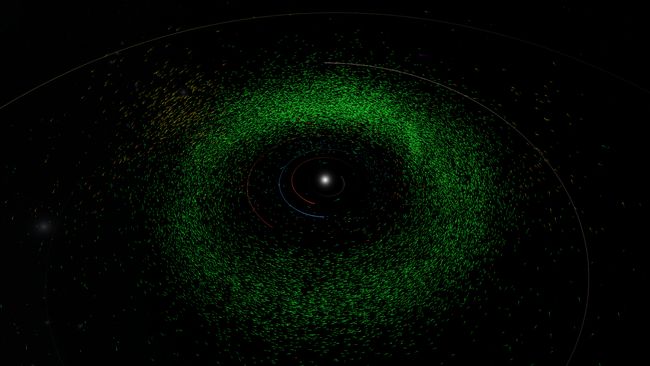Scientists scale up asteroid search algorithm using cloud computing
More than 27,000 asteroids in our solar system have been spotted thanks to an artificial intelligence-based algorithm. The scientists behind the discovery say the tool makes it easier to find and track millions of asteroids, including potentially hazardous ones, that could someday impact Earth. It will take years before trying to divert them from our planet.
Most of the discovered asteroids float in the asteroid belt between Mars and Jupiter, where scientists have already cataloged more than 1.3 million large objects over the past 200 years. The latest discoveries include about 150 asteroids whose paths are tangential to Earth's orbit. However, none of them appear to be on a collision course with our planet. Others — “Trojans” that follow Jupiter in its orbit around the Sun. Observations of these asteroids have been accepted by the International Astronomical Union's Minor Planet Center, the official body responsible for asteroid discoveries.
Astronomers find new asteroids by studying areas of the sky using images from telescopes collected several times each night — usually every few hours. While the planets, stars and galaxies in the background remain the same from one image to the next, asteroids are visible as blobs that move noticeably, then they are tagged and checked. This is how the orbits of these asteroids are determined and controlled.
«This is a job for AI. In fact, artificial intelligence tools designed to find asteroids are already approaching levels achievable by humans. I think we will quickly surpass this level over the next few weeks», — Ed Lu, executive director of the Asteroid Institute and co-founder of the B612 Foundation, said during a discussion of the discovery.
Lu's team's Tracklet-less Heliocentric Orbit Recovery, or THOR, algorithm analyzed more than 400,000 archived images stored at the National Optical Infrared Astronomy Research Laboratory, or NOIRLab. As long as there are about five observations associated with the same part of the sky in 30 days, the algorithm can start working. It is trained on a large data set, allowing it to analyze up to 1.7 billion points in just one telescope image. It is designed to detect and connect a point in one image to another point in the next image, and to determine whether both points represent the same object. most often it indicates an asteroid, according to the B612 Foundation algorithm description.
According to a statement released April 30 by the B612 Foundation, the scientists scaled their algorithm with the help of Google Cloud, whose computing power and storage services have made it easier for scientists to test thousands of asteroid candidate orbits.
«Not only can we find asteroids in data sets that were never intended to be found, we can improve another telescope in the world at finding asteroids», — Lou said.
In 2022, the same team of scientists used THOR to discover 100 asteroids that were not detected in existing telescope images. Other teams of astronomers have also used artificial intelligence to find new asteroids. Just two weeks ago, for example, citizen scientists led the training of an algorithm that led to the discovery of 1,000 new asteroids in archival images taken by the Hubble Space Telescope. Last July, software called HelioLinc3D, designed to search for near-Earth asteroids, discovered a 180-meter-wide object that was expected to come within 225,000 kilometers of Earth. This is closer than the average distance between our planet and the Moon.
To date, scientists have discovered more than 2,000 of these “potentially hazardous asteroids,” and it is estimated that about 2,000 more remain to be detected. Finding these objects to aid planetary defense is one of the goals of the future Vera Rubin Observatory in Chile, for which HelioLinc3D asteroid-hunting software has been developed.
The
8.4-meter telescope, which begins operation next year, will image the southern sky every night for at least ten years, with each image covering an area of 40 full Moons. Scientists say this frequency, supported by artificial intelligence software such as THOR and HelioLinc3D, could help the observatory find up to 2.4 million asteroids — twice as many as those currently cataloged — for the first six months of operation.

